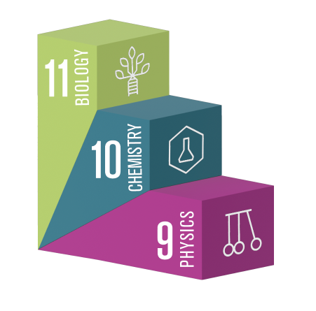
Patterns
High School Science for All
Patterns Science Overview
The Patterns High School Science Sequence is a three year course pathway and curriculum aligned to the Next Generation Science Standards (NGSS).
Each course utilizes:
Common instructional strategies
Real world phenomena
Design challenges to engage students and support their learning.
The curriculum is a combination of teacher-generated and curated open-content materials. The Teacher-generated materials are shared freely under a Attribution-NonCommercial-Sharealike Creative Commons License.
Teacher workshops for each course are offered each summer in the Portland, Oregon Metro area. In addition, during the school year we offer free professional development in the following formats:
Unit websites
Workshops
PLCs during the school year.
For more information on these opportunities, please see our Professional Development page.
The Patterns Approach
The Patterns Approach to science instruction emphasizes the use of mathematical and phenomenological patterns to predict the future and understand the past.
Harnessing their own experiences, students compare and contrast low-evidence predictions (wild guesses) to their data-informed prediction to live the experience and learn the value of evidence-based reasoning. Additionally, students engage in several engineering projects in each course, where they must use the Patterns they discover in their designs to optimize their solutions.
The Patterns Approach utilizes:
technology
student-constructed knowledge
frequent opportunities for student talk, and language supports to ensure the engagement and success of every student.
By emphasizing, rather than removing, the mathematical connections to science, the Patterns Approach supports student conceptual understanding by:
connecting real-world inquiry experiences
using graphical representations and mathematical representations of science phenomena.
For more on the Patterns Approach, read lead physics course developer Bradford Hill’s article in The Science Teacher: “The Patterns Approach – Engaging Freshmen in the Practices of Science.”
What is Patterns?
This is a recorded webinar that is targeted for teachers and/or district leaders who want to know more about the open-source Patterns curriculum. An overview of why these courses were created, the Design Principles that the three courses are based on, program evaluation data, and how the 3 courses (Physics, Chemistry, & Biology) work together as a sequence to prepare students for college and career are provided. The link to the powerpoint that was used during the presentation is also provided.
Don’t have time to watch the whole webinar? Check out this shorter video in the meantime.
High School Science for All Curriculum
This curriculum is licensed under a Creative Commons Attribution-Non Commercial-ShareAlike 4.0 International License.
For more information, contact us at info@pdxstem.org.
Information on how to complete the
Patterns Independent Adoption in Oregon
Core Sequence Documents
-
The Design Principles - Our framework for science and engineering education that guides the development of the Patterns curriculum and instructional practices. See also the Two-Pager for all stakeholders.
-
-
Vertical Articulation and Resource Guide - A toolkit of reading, writing, speaking, collaboration, and three dimensional protocols, skills, and tools that are used throughout the sequence.
-
Equipment List - This spreadsheet is updated to include the equipment (consumables and non-consumables) that are needed to teach each of the Patterns courses. This is updated yearly. For instructions on how to use this document, see this guide.
You will find individual equipment lists for each course on their home page.
-
Next Generation Science Standards by Course - This spreadsheet shows which NGSS performance expectations (PEs) are in each of the three courses in the sequence.
-
This slide deck supports an integral part of the Patterns curriculum, a data discussion. Prompts are provided for both for teachers and students
-
View the Talk Protocol Flowchart here.
-
-
-
-
-
-
This background paper, along with the PD slide deck, provides teachers with information to encourage them to use one or more of the integrated science-art lessons in their Patterns curriculum.
-




